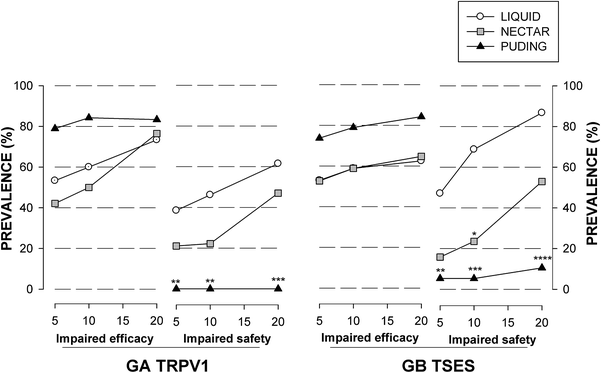

The most prevalent sign of impaired safety of swallow was voice change observed in up to 43.65%. According to a study carried out by our group, the prevalence of post-stroke (PS) OD on admission was 45%, with up to 38% patients showing clinical signs of impaired safety of swallow. Oropharyngeal dysphagia (OD) is one of the most important causes of disability and mortality in patients who have suffered a stroke. Stroke is the second cause of death in the world and is also a leading cause of disability, which is expected to increase in the coming decades with high socioeconomic costs. Acute PSOD patients present poor nutritional status, hydropenia, and high risk for respiratory complications. SSF is significantly reduced in PSOD in comparison with PSnOD. There were no differences for saliva SP concentrations. Bioimpedance showed intracellular dehydration in 37.50% PSOD vs none in PSnOD. Nutritional risk was observed in 62.92% PSOD vs 11.11% PSnOD ( p = 0.007) and visceral protein markers were also significantly reduced in PSOD ( p < 0.05). SSF was significantly reduced in PSOD, 0.23 ± 0.18 and PSOD with impaired safety, 0.22 ± 0.18 vs 0.48 ± 0.29 swallows/minute in PS without OD (PSnOD) (both p < 0.005). Twenty-seven PS patients (60%) had OD 19 (40%), impaired safety of swallow. Nutritional status was evaluated by Mini Nutritional Assessment Short Form (MNA-sf) and blood analysis. Hydration status was assessed by bioimpedance. Saliva samples were collected with a Salivette® to determine SP by ELISA. SSF/minute was assessed through 10-min neurophysiological surface recordings including suprahyoid-electromyography and cricothyroid-accelerometry. The Volume-Viscosity Swallowing Test (V-VST) was performed for clinical diagnosis of OD. In this study we aimed to compare SSF, salivary SP concentration, hydration and nutritional status in post-stroke (PS) patients with and without OD. Likewise, the reduction of saliva substance P (SP) concentration has been associated with an increased risk of aspiration and a decrease in SSF. In recent years, an association between reduced spontaneous swallowing frequency (SSF) and OD has been described.

Early detection of PSOD is essential to reduce morbidity and mortality in patients with acute stroke. Oropharyngeal dysphagia (OD) is a frequent complication after stroke (PSOD) that increases morbidity and mortality.


 0 kommentar(er)
0 kommentar(er)
